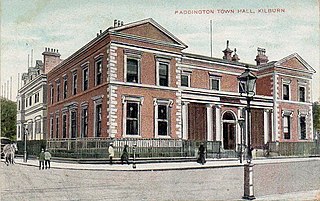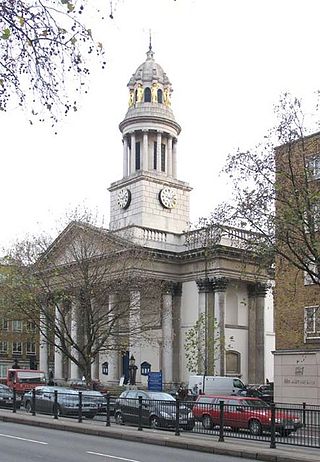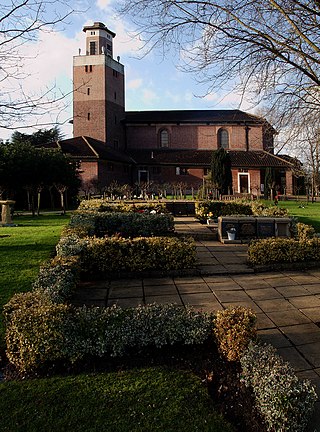

Paddington Street Gardens are two small public gardens located either side of Paddington Street in the Marylebone area of London.
Contents
The larger south garden contains a children's playground.


Paddington Street Gardens are two small public gardens located either side of Paddington Street in the Marylebone area of London.
The larger south garden contains a children's playground.
The gardens were built in the 18th century as additional burial grounds for the St Marylebone Parish Church. The land on the south side was donated by Edward Harley, 2nd Earl of Oxford and Earl Mortimer in 1730. The land on the north side was later purchased in 1771.
The two burial grounds (either side of Paddington Street) were closed to burials in 1814. The Metropolitan Public Gardens Association arranged for the burial grounds to be opened as a public recreation ground in 1885, and the Association's landscape gardener Fanny Wilkinson (Britain's first female professional landscape gardener) laid out the gardens. The original lime and London plane trees survive. The gardens were officially opened on 6 July 1886 by Princess Louise, Duchess of Argyll. [1]
The majority of the tombstones were removed, although some can still be seen around the edge of the gardens. The mausoleum in the south garden also remains. This was erected by the Hon Richard Fitzpatrick (the younger son of Richard FitzPatrick, 1st Baron Gowran) in 1759 in memory of his wife. [2] It is Grade II listed. [3]

Westminster is the main settlement of the City of Westminster in London, England. It extends from the River Thames to Oxford Street and has many famous landmarks, including the Palace of Westminster, Buckingham Palace, Westminster Abbey, Westminster Cathedral, Trafalgar Square and much of the West End cultural centre including the entertainment precinct of West End Theatre.

The City of Westminster is a London borough with city status in Greater London, England. It is the site of the United Kingdom's Houses of Parliament and much of the British government. It contains a large part of central London, including most of the West End, such as the major shopping areas around Oxford Street, Regent Street, Piccadilly and Bond Street, and the entertainment district of Soho. Many London landmarks are within the borough, including Buckingham Palace, Westminster Abbey, Whitehall, Westminster Cathedral, 10 Downing Street, and Trafalgar Square.

The West End of London is a district of Central London, London, England, west of the City of London and north of the River Thames, in which many of the city's major tourist attractions, shops, businesses, government buildings and entertainment venues, including West End theatres, are concentrated.

Paddington is an area in the City of Westminster, in central London, England. A medieval parish then a metropolitan borough of the County of London, it was integrated with Westminster and Greater London in 1965. Paddington station, designed by the engineer Isambard Kingdom Brunel opened in 1847. It is also the site of St Mary's Hospital and the former Paddington Green Police Station.

Paddington was a civil parish and metropolitan borough in London, England. It was an ancient parish in the county of Middlesex, governed by an administrative vestry. The parish was included in the area of responsibility of the Metropolitan Board of Works in 1855 and became part of the County of London in 1889. The parish of Paddington became a metropolitan borough in 1900, following the London Government Act 1899, with the parish vestry replaced by a borough council. In 1965 the borough was abolished and its former area became part of the City of Westminster in Greater London.

Frogmore is an estate within the Home Park, adjoining Windsor Castle, in Berkshire, England. It comprises 33 acres (130,000 m2), of primarily private gardens managed by the Crown Estate. It is the location of Frogmore House, a royal retreat, and Frogmore Cottage. The name derives from the preponderance of frogs which have always lived in this low-lying and marshy area near the River Thames. This area is part of the local flood plain. Its large landscaped gardens are Grade I listed on the Register of Historic Parks and Gardens.

West Norwood Cemetery is a 40-acre (16 ha) rural cemetery in West Norwood in London, England. It was also known as the South Metropolitan Cemetery. One of the first private landscaped cemeteries in London, it is one of the "Magnificent Seven" cemeteries of London, and is a site of major historical, architectural and ecological interest.

Cities of London and Westminster is a constituency returning a single Member of Parliament (MP) to the House of Commons in the United Kingdom Parliament. As with all constituencies, the election is decided using the first past the post system of election. From its creation at the 1950 general election to the 2024 general election, the constituency had always elected the candidate nominated by the Conservative Party.
Lisson Grove is a street and district in the City of Westminster, West London. The West End neighbourhood contains a few important cultural landmarks, including Lisson Gallery, Alfies Antique Market, Red Bus Recording Studios, the former Christ Church, now the Greenhouse Centre, and the Seashell of Lisson Grove.

St George's Fields are a former burial ground of St George's, Hanover Square, lying between Connaught Street and Bayswater Road in Tyburnia deconsecrated and sold off by the Church Commissioners in the 1970s to be built upon by The Utopian Housing Association, a housing trust.

St Marylebone Parish Church is an Anglican church on the Marylebone Road in London. It was built to the designs of Thomas Hardwick in 1813–17. The present site is the third used by the parish for its church. The first was further south, near Oxford Street. The church there was demolished in 1400 and a new one erected further north. This was completely rebuilt in 1740–42, and converted into a chapel-of-ease when Hardwick's church was constructed. The Marylebone area takes its name from the church. Located behind the church is St Marylebone School, a Church of England school for girls.

The New Road was a toll road built across fields around the northern boundaries of London, the first part of which opened in 1756. The route comprises the modern-day A501.

Paddington Recreation Ground is a park in Maida Vale, City of Westminster, just north of Paddington. Its 27-acre site is the largest area of parkland located entirely within the City of Westminster. It was the first park of its kind in London, having operated since 1888. Annually, it attracts over 1.5 million users, who visit the Recreation Ground for its green-space value.

East Finchley Cemetery is a cemetery and crematorium in East End Road, East Finchley. Although it is in the London Borough of Barnet, it is owned and managed by the City of Westminster.

Marylebone is an area in London, England and is located in the City of Westminster. It is in Central London and part of the West End. Oxford Street forms its southern boundary.

St John's Wood Church Grounds is a disused graveyard which is now a public park in St. John's Wood in London. It is a Site of Borough Importance for Nature Conservation, Grade 1, and the only Local Nature Reserve in the City of Westminster. Since 2004 it has received the Green Flag Award for excellent green spaces. It is owned and managed by Westminster Council.

Quaker Gardens is a small public garden in the extreme south of the London Borough of Islington, close to the boundary with the City of London, in the area known historically as Bunhill Fields. It is managed by Islington Borough Council. It comprises the surviving fragment of a former burying ground for Quakers, in use from 1661 to 1855. George Fox, one of the founders of the movement, was among those buried here.

Paddington Street is a street in the City of Westminster in London that runs from the junction of Crawford Street and Baker Street in the east to Marylebone High Street in the west.
The Metropolitan Public Gardens Association is a charity in London for the purposes of the preservation of public parks and gardens, established in 1882. It facilitated the creation of new public open spaces, including from philanthropic landowners within its membership. The MPGA was involved in the formation and development of other amenity organisations. The charity still exists; in recent decades its emphasis has changed to smaller parcels of land and smaller projects within larger spaces, as well as to themed projects. The MPGA was the starting point for the careers of the ground-breaking female landscape gardeners Fanny Wilkinson and Madeline Agar.

Meath Gardens is a 4.1642 hectares park in Bethnal Green in the London Borough of Tower Hamlets in East London, England, and opened to the public in 1894. Before it became a park, it was the Victoria Park Cemetery.